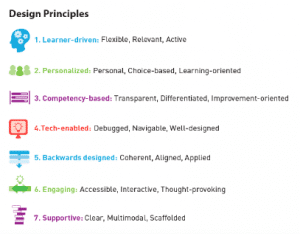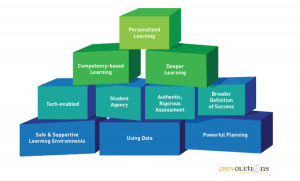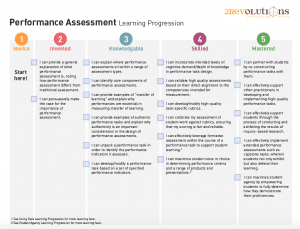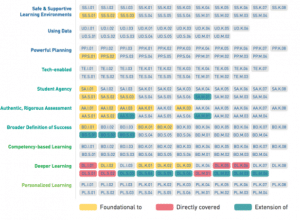Getting Closer to the Future of Teacher Learning
CompetencyWorks Blog

This post and all graphics originally appeared at 2Revolutions on May 12, 2017.
As I discussed in my earlier piece on the future of teacher learning, there is the need to transform what and how teachers learn in school districts, charter management organizations (CMOs), and state systems. While I’m confident from our experiences at 2Rev that there are no cookbook recipes to doing this — since every context, community, and culture is unique and the needs of the adult learners are vast and varied — I’m also confident that people need support to help them move in the right direction. In this post, I share some strategies and tools that have helped us move teacher learning with our partners.
#1 – Design Principles for Adult Learning

Over the past several years, our team has been refining our approach to designing personalized, job-embedded, learner-driven learning experiences that support and coach educators as they transition to future-oriented learning models. Much of our work with adults stems from our growing understanding of andragogy and deeply held beliefs in the importance of mindset as a gateway to transformed learning — why should we ask professional educators to spend time doing something that feels irrelevant to their craft, tangential, and/or is just plain boring or uninspiring?
With that in mind, we created a set of design principles as guideposts for how we think about and plan for adult learning experiences. These principles (right) guide us and serve as a screen for creating an optimal learning experience.
Can you create your own design principles for adult learning? How do these principles align to the principles you consider necessary for high-quality student learning to occur?
#2 – A Framework to Make Relationships Between Ideas Visible
The Future of Learning has many components; one approach that many partners in our field are working towards is personalizing learning for all learners. When you describe the idea of personalizing the learning experience for each individual student so that you can meet them where they are, accelerate and deepen their learning, and help make it more relevant and engaging, most teams we work with are compelled to do so.
But how? The rationale is clear and compelling but the path to get there can be more challenging. Masterful teachers have been doing this type of pedagogical practice for decades, but at the scale of a district or state, where you do begin to support teachers in making this transition? How do you build educator capacity for facilitating this type of learning experience?
Given that each person we work with comes to the table at different points of entry, over time, it became clear that we needed a navigation tool. With the need to orient individuals and systems, we identified a set of Building Blocks — key instructional and assessment practices — that are important to enabling educators to deepen their ability to personalize learning. The relationship between the items is important; schools need foundational elements, like a Safe and Supportive Learning Environment, before they can effectively and deeply adapt the learning experience for students toward greater complexity. It would be impossible to truly personalize instruction, without knowing how to Use Data and approach it through an action research lens (if the data says, “x”, what does it mean and what do we do with that information?). Often, in our work with districts, the leadership team will identify the key instructional and assessment building blocks in their context and arrange them in ways that make sense for them. Once they do so, we then help them design scaffolded learning experiences against this framework using a blend of online resources on InspirED, problem-based design experiences and workshops, and one-on-one coaching.

Based on what you are trying to do as a district or school leadership team, what type of learning are you driving toward and what are the necessary building blocks to move your instruction and assessment to help you get there?
#3 – Everyone Needs a GPS
The Building Blocks alone are helpful, but insufficient. You might recognize that your team needs to improve your approach to student agency across the board, but how? What next? We need maps of various sorts to help us navigate, especially when we are traveling to new places. Over the past decade, a big innovation in our world has been GPS, especially when it was democratized to our phones — where am I and where am I trying to go? What if we could do that more coherently for teachers and systems leaders? Using our building blocks as the field of play, we have begun to design a few different navigational tools for system leaders and teachers. One example is the Deeper Learning Continuum below. It helps users get to the root of the questions: Where is my school against my goals of transformation towards deeper learning? What should I look for to know where we are? The continuum helps teams develop a shared understanding for defining deeper learning and the key instruction and assessment “look-fors” that can help them uncover where they are against their goals, and then design learning experiences and opportunities to empower them to move to the next step.

Our partners are beginning to use this tool as a way to norm around language and have central office leadership support building leaders in goal setting. The beauty of this tool is that it provides an opportunity to reflect on points of pride and areas of growth, and provides continuity to the conversations over time.
#4 – A Progression of Learning
While the Deeper Learning Continuum is helpful for system and school leaders, there is the need for something more granular and focused at the level of teacher practice when it comes to understanding where your understanding is around topical content knowledge and skills against the Building Blocks. Adult learning progressions help teachers locate themselves on a continuum and set goals for improving their practice. See below an example of an adult learning progression, and click here for a list of topical progressions. We have worked with schools that “heat map” their teachers by using these progressions to assess knowledge and skills, and then tailor professional learning to the clusters of need that emerge from the data. We have supported other systems that use the progressions as an opportunity for teachers to take stock and then access correlated playlists and courses to personalize their own knowledge and skill development. There are many different avenues to explore.

#5 – The Connection Between Competencies
How does one competency connect to another? Inspired by work that has been done by Jeff Baumes on charting the dependencies of mathematical standards, we have begun to map adult learning competencies and how specific competencies are connected to others: what is foundational to, what is directly covered by, and what represents extended opportunities for a specific competency? This type of mapping offers an opportunity for greater coherence and educator agency in constructing the learning path that makes the most sense for their own learning needs. Also, this helps us better understand how different instructional and assessment strategies implicate others, getting at the connections and interdependencies between these approaches.

None of these strategies or tools alone are a panacea; the work of rethinking teacher learning will never be solved with a tool alone, just like the work of rethinking students’ experiences in school cannot be solved by implementing one great protocol or tool. Facilitating immersive, impactful, deep learning is an art and science, as well as a journey of creating a culture of learning, but it’s imperative that if we say we want personalized and competency-based learning for kids, we walk the talk of it for how we structure the process of our adult learning.
See also:
- Peeking Around the Corner: Insights on the Future of Learning
- Who is Helping You Plan and Implement Competency Education?
- Design Thinking
Adam has spent over two decades catalyzing change through the design and launch of social enterprises across the education and community development sectors. He started 2Revolutions to feed this love, and to reinforce a belief that two critical levers we can pull are the birth and scaling of innovative ventures as a way to affect real change. At 2Rev, Adam is able to feed his love of both systems change and practice innovation.